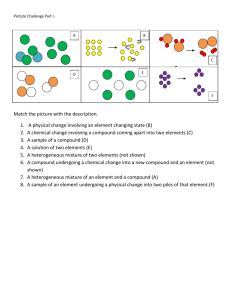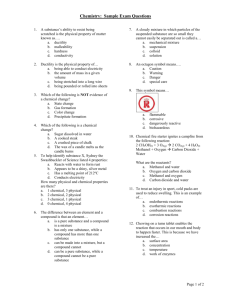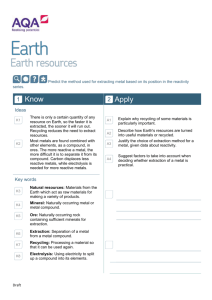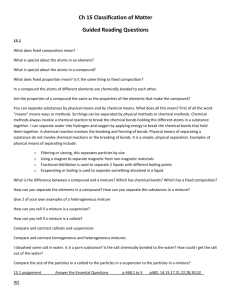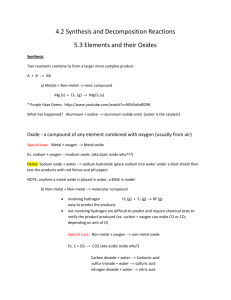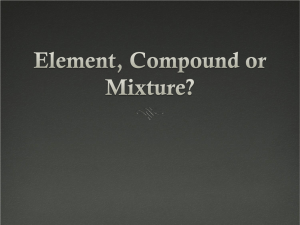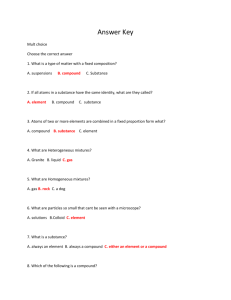Chemicals
advertisement
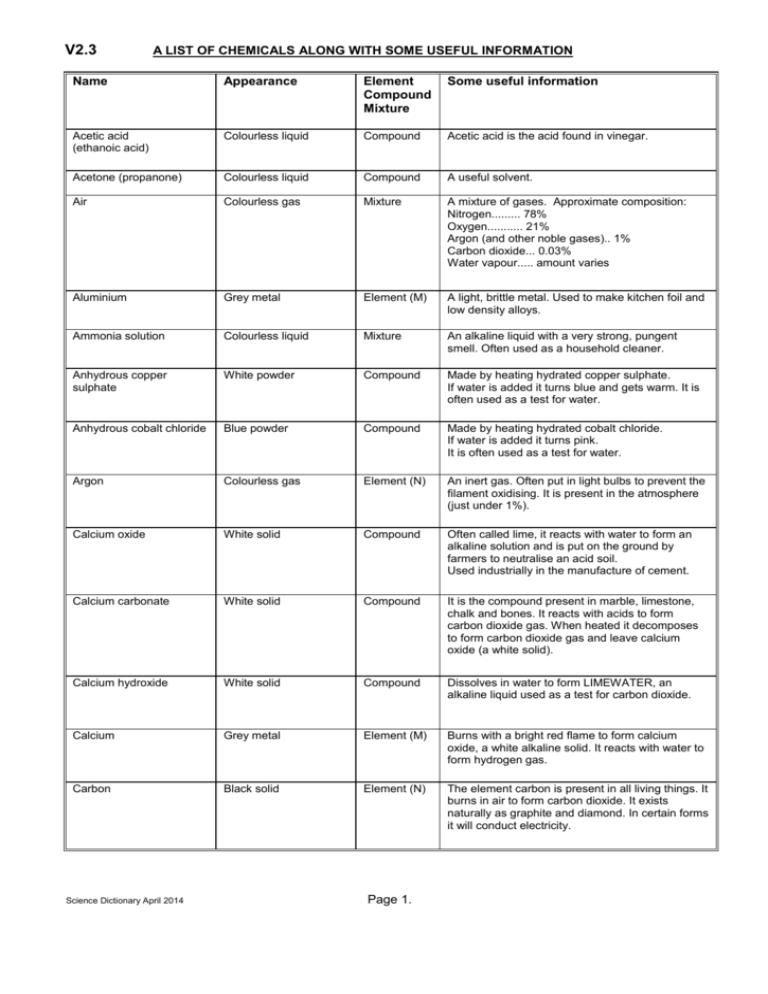
V2.3 A LIST OF CHEMICALS ALONG WITH SOME USEFUL INFORMATION Name Appearance Element Compound Mixture Some useful information Acetic acid (ethanoic acid) Colourless liquid Compound Acetic acid is the acid found in vinegar. Acetone (propanone) Colourless liquid Compound A useful solvent. Air Colourless gas Mixture A mixture of gases. Approximate composition: Nitrogen......... 78% Oxygen........... 21% Argon (and other noble gases).. 1% Carbon dioxide... 0.03% Water vapour..... amount varies Aluminium Grey metal Element (M) A light, brittle metal. Used to make kitchen foil and low density alloys. Ammonia solution Colourless liquid Mixture An alkaline liquid with a very strong, pungent smell. Often used as a household cleaner. Anhydrous copper sulphate White powder Compound Made by heating hydrated copper sulphate. If water is added it turns blue and gets warm. It is often used as a test for water. Anhydrous cobalt chloride Blue powder Compound Made by heating hydrated cobalt chloride. If water is added it turns pink. It is often used as a test for water. Argon Colourless gas Element (N) An inert gas. Often put in light bulbs to prevent the filament oxidising. It is present in the atmosphere (just under 1%). Calcium oxide White solid Compound Often called lime, it reacts with water to form an alkaline solution and is put on the ground by farmers to neutralise an acid soil. Used industrially in the manufacture of cement. Calcium carbonate White solid Compound It is the compound present in marble, limestone, chalk and bones. It reacts with acids to form carbon dioxide gas. When heated it decomposes to form carbon dioxide gas and leave calcium oxide (a white solid). Calcium hydroxide White solid Compound Dissolves in water to form LIMEWATER, an alkaline liquid used as a test for carbon dioxide. Calcium Grey metal Element (M) Burns with a bright red flame to form calcium oxide, a white alkaline solid. It reacts with water to form hydrogen gas. Carbon Black solid Element (N) The element carbon is present in all living things. It burns in air to form carbon dioxide. It exists naturally as graphite and diamond. In certain forms it will conduct electricity. Science Dictionary April 2014 Page 1. Carbon dioxide Colourless gas Compound A dense gas (heavier than air). Does not support combustion. It is the gas produced during respiration in living organisms and used by plants during photosynthesis. It is present in the atmosphere (about 0.03%) and causes rainwater to be slightly acidic. The test for carbon dioxide is to bubble it through limewater which will go milky. Used in fire extinguishers and fizzy drinks. Citric acid White crystals Compound Citric acid is the compound which gives lemons and other citrus fruits their sharp taste. Cobalt chloride (hydrated) Pink crystals Compound If heated it will decompose to form anhydrous cobalt chloride (blue) and give off water vapour. Copper sulphate (hydrated) Blue crystalline solid Compound If heated it will decompose to form anhydrous copper sulphate (white) and give off water vapour. Copper oxide Black powder Compound Reacts with dilute sulphuric acid to form a blue solution of copper sulphate. Copper carbonate Green powder Compound If heated it will decompose to form copper oxide (a black powder) and evolve carbon dioxide gas. Copper Pink metal Element (M) If heated it forms a black layer of copper oxide on the surface. Used to make electric wires and water pipes. Ethanol (alcohol) Colourless liquid Compound Flammable liquid produced by the fermentation of sugars (using yeast). Often used as a solvent. Alcohol burns to form carbon dioxide and water. Gold Yellow metal Element (M) Very dense unreactive metal. Will not tarnish. Used in jewellery. Often used to coat electrical contacts eg in switches. Graphite Black solid Element (N) Graphite is a form of carbon. It is the black substance used to make pencil leads. Graphite will conduct electricity. Hydrochloric acid (dilute) Colourless liquid Mixture Used in the laboratory prep. of carbon dioxide by reacting it with marble chips. Hydrogen Colourless, flammable gas Element (N) The least dense (lightest) of all substances. The test for hydrogen is to see if it burns with a squeaky pop. It burns to form water. Iodine Grey solid Element (N) Sublimes into a purple vapour when heated. Iodine is an important test for STARCH. If a drop of iodine solution is placed onto some starch a blue/black colour is formed. Iron Grey metal Element (M) It is the only common metal attracted to a magnet. It reacts slowly with acids and goes rusty when exposed to a mixture of air and water. (Rust is hydrated iron oxide). Iron oxide Brown powder Compound It is the compound found in iron ore from which iron can be obtained by reduction with carbon. It can be coated over thin plastic to make up recording tape or floppy disks. Science Dictionary April 2014 Page 2. Lead Grey metal Element (M) Soft grey, heavy metal. It is not very reactive and is sometimes used as a roof covering. Limewater Colourless liquid Mixture An alkaline liquid that turns milky when carbon dioxide gas is bubbled through it. (used as a test for carbon dioxide). Litmus indicator Purple liquid when neutral. Can also be red or blue. Mixture Used as a test for acids or alkalis. Red litmus turns blue when added to an acid. Blue litmus turns red when added to an alkali. Magnesium oxide White solid Compound Dissolves in water to form magnesium hydroxide, a weak alkali. Magnesium hydroxide White solid Compound A mild alkali used to make 'Milk of magnesia', a medicine used to help acid indigestion. Magnesium Grey metal Element (M) It burns with an intense white flame to form magnesium oxide, a white solid that dissolves in water to form an alkaline solution. Mercury Grey liquid metal Element (M) The only liquid metal. Very dense (heavy). Sometimes used in tilt switches. Nitrogen Colourless gas Element (N) The most abundant gas in the atmosphere. It is not very reactive. Important as a plant food and so is often used in fertilizers. Makes up about 78% of the atmosphere. Oxygen Colourless gas Element (N) Oxygen is needed by living organisms for respiration. It is produced by plants during photosynthesis. It supports combustion. It makes up about 21% of the atmosphere. The test for oxygen is see if it relights a glowing splint. Main industrial use is in the steel industry. also used for welding, in hospitals and in rocket fuels. Prepared in the lab. by heating potassium permanganate and in industry by the fractional distillation of liquid air. Petrol Pale yellow liquid Mixture of compounds Potassium permanganate Dark purple crystals Compound Sodium Grey metal Element (M) Petrol is a HYDROCARBON. Like all hydrocarbons it will burn to form carbon dioxide and water. When heated it DECOMPOSES to form oxygen gas. Soft grey metal. Very reactive. Reacts violently with water to form am alkaline solution. Dangerously reactive with acids. Sodium carbonate White solid Compound Dissolves easily to form an alkaline solution. It is used to make WASHING SODA. Sodium hydroxide White solid Compound Sulphur Yellow solid Element (N) Dissolves readily in water to form a strong alkali. Very caustic - must be handled with great care. If heated it first MELTS into an orange liquid and then BURNS to form a pungent smelling acidic gas called sulphur dioxide. Sulphur dioxide Acidic gas with a pungent smell. Compound Science Dictionary April 2014 Page 3. Dissolves easily in water to form an acidic solution. It is the gas responsible for acid rain and is often formed when fossil fuels are burnt. Sulphuric acid (dilute) Colourless liquid Mixture Often used to produce hydrogen gas by reacting it with granulated zinc. Universal indicator Green liquid Mixture Universal indicator is used to test the pH value of a solution. See separate table. Water Colourless, neutral liquid Compound Water is a compound of hydrogen and oxygen. It is formed when either hydrogen gas or any hydrocarbon (eg wax, petrol, natural gas) is burnt. It has a boiling point of 100oC and freezes at 0oC. Water is a good solvent. It is a vital component in all living things. Wax Translucent solid Mixture of compounds Wax is a HYDROCARBON. Like all hydrocarbons it will burn to form carbon dioxide and water. The flame from a burning candle looks yellow due to small, very hot specks of soot (carbon). Being a mixture it does not have a definite melting point. Zinc oxide White powder Compound It turns yellow when hot but white again when cold. Zinc Grey metal Element (M) Used in the laboratory preparation of hydrogen gas by reacting it with dilute sulphuric acid. Sometimes plated over iron to stop the iron rusting (called galvanized iron) Science Dictionary April 2014 Page 4.


